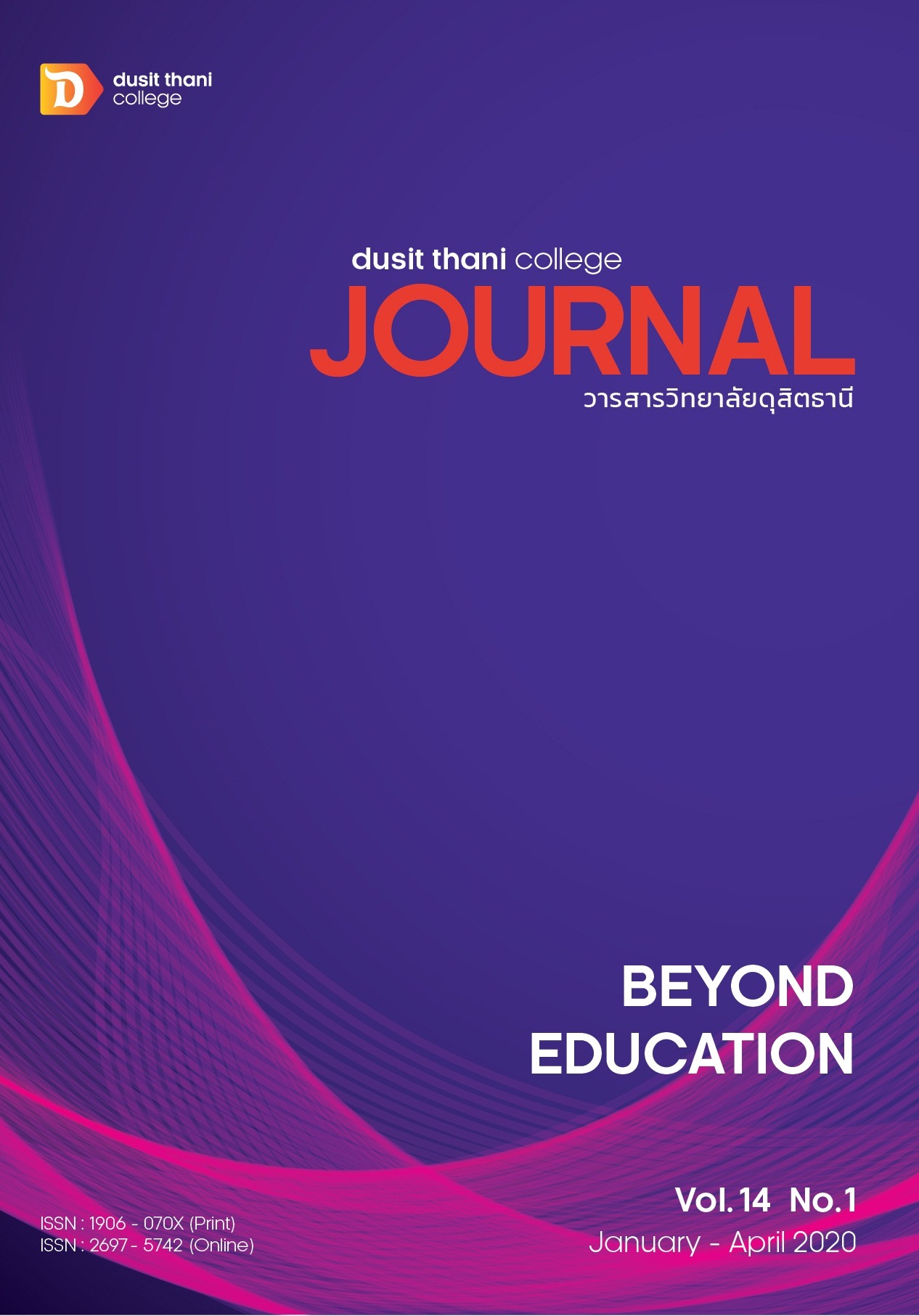The Association Rules of Factors on Customer Choices of Accommodation: Pak Chong, Nakhon Ratchasima
Main Article Content
Abstract
Accommodation plays a crucial role in facilitating visitors when they are traveling. It can be noticed that the hotel is the main factor which affects a lot on visitors’ decisions. If any tourist attractions are not able to provide good accommodation, it will decrease the number of visitors who would travel and spend the nights. Thus, to indicate the factors which affect customer choices on accommodation. The research had been conducted based on the 452 online surveys targeting the tourists who spent more than one night in Pak Chong area, Nakhon Ratchasima province. A Qualitative research method, the association rules, investigates the relationship of factors which consists of the personal information and some improvement factors; Accommodation, Attraction, Activities, Amenities, and Accessibility. The research objective is to provide accommodation improvement guidance which concluded from the rules of the association for increasing the number of visitors in the Pak Chong area. The outcome suggests the effective accommodation should provide interesting activities such as paintball, rafting, biking and other facilities such as free internet connection, free transportation to the hotel. The cleanness, well-prepared decoration, and safety of accommodation is an important factor that should keep in consideration firstly. In summary, all mentioned factors are the main factors that directly affect the customer choices.
Article Details
Article Screening Policy
- All research and academic articles to be published must be considered and screened by three peer reviews in the relevant field / article.
- All articles, texts, illustrations and tables published in the journal are the personal opinions of the authors. Editors don't always have to agree. And no responsibility whatsoever is the sole responsibility of the author.
- The articles to be published must never be published. Where did you first publish? And not in the consideration of other journals If the audit found that there has been a duplicate publication It is the sole responsibility of the author.
- Any article that the reader sees as being plagiarized or impersonated without reference. Or mislead the work of the author Please let the journal editor know it will be your greatest blessing.
References
2. Boonvarasatit, S., Homsin, P., & Srisuriyawet, R. (2016). Factors Influencing Health-Promoting Behaviors Among Prison Officers in Department of Corrections, Nakhon Ratchasima Province. The Public Health Joournal of Burapha University, 11(1), 52 - 60. (in Thai)
3. Dellaert, B. G. C., Ettema, D. F., & Lindh, C. (1998). Multi-faceted tourist travel decisions:A constraint-based conceptual framework to describe tourists' sequential choices of travel components. Tourism Management, 19(4), 313 - 320. doi:10.1016/S0261-5177(98)00037-5
4. Dickman, S. (1997). Tourism : an introductory text. Sydney: Hodder Headline.
5. Francis, B., & Bungkwon, B. (1996). Hotel marketing strategy and the theory of reasoned action. International Journal of Contemporary Hospitality Management, 8(3), 5 - 10. doi:10.1108/09596119610115943
6. Han, H., Hsu, L.-T., & Sheu, C. (2010). Application of the Theory of Planned Behavior to green hotel choice: Testing the effect of environmental friendly activities. Tourism Management, 31(3), 325-334. doi:https://doi.org/10.1016/j.tourman.2009.03.013
7. Hyde, K. F. (2008). Information processing and touring planning theory. Annals of Tourism Research, 35(3), 712 - 731. doi:10.1016/j.annals.2008.05.001
8. Kaewpitoon, S. J., Loyd, R. A., & Kaewpitoon, N. (2015). A cross-sectional survey of intestinal helminthiases in rural communities of nakhon ratchasima province, Thailand. J Med Assoc Thai, 98(Suppl 4), S27 - S32. (in Thai)
9. Knutson, B. J. (1988). Frequent travelers: Making them happy and bringing them back.
The Cornell Hotel and Restaurant Administration Quarterly, 29(1), 83 - 87.
10. Law, R., & Au, N. (1998). A Rough Set Approach To Hotel Expenditure Decision Rules Induction. Journal of Hospitality & Tourism Research, 22(4), 359 - 375. doi:10.1177/109634809802200403
11. Magnini, V. P., Earl D. Honeycutt, J., & Hodge, S. K. (2003). Data Mining for hotel Firms: Use and Limitations. Cornell Hotel and Restaurant Administration Quarterly(April), 94 - 105. doi:10.1177/0010880403442009
12. McCleary, K. W., Weaver, P. A., & Hutchinson, J. C. (1993). Hotel selection factors as they relate to business travel situations. Journal of Travel Research, 32(2), 42 - 48.
13. MOTS. (2016). Domestic Tourism Statistics (Classify by region annd province). Ministry of Tourism & Sports, Thailand Retrieved from https://www.mots.go.th/ewt_dl_link.php?nid=8815. (in Thai)
14. Oppewal, H., Huybers, T., & Crouch, G. I. (2015). Tourist destination and experience choice: A choice experimental analysis of decision sequence effects. Tourism Management, 48, 467-476. doi:https://doi.org/10.1016/j.tourman.2014.12.016
15. Phandee, M. C., & Pinthong, P. (2012). The Agricultural Areas Potentials Development forAgro-Tourism Using Geographic Information System. International Journal of Innovation, Management and Technology, 3(6), 647.
16. Rao, S., & Gupta, P. (2012). Implementing Improved Algorithm Over APRIORI Data Mining Association Rule Algorithm 1.
17. Sodsai, C., Kosol, K., Samran, S., Somchai, P., & Somchai, L.-a. (2012). Commercial corn hybrids trial on farmer's fields in Pakchong District, Nakhon Ratchasima Province. (in Thai)
18. Taninecz, G. (1990). 1990 Business Traveler Survey. Hotel and Motel Management, 205(57), 29 - 32.
19. Tungprasert, S. (2014). A Sustainable Development of Agro Tourism Human Resource in Nakhon Ratchasima under Sufficiency Economy Philosophy. Review of Integrative Business and Economics Research, 3, 1.
20. Turner, R. (2017). Travel and Tourism Economic Impact 2017 - March 2017 (Thailand). Retrieved from https://www.wttc.org/-/media/files/reports/economic-impact-research/countries-2017/thailand2017.pdf
21. Woodside, A. G., & Lysonski, S. (1989). A General Model Of Traveler Destination Choice. Journal of Travel Research, 27(4), 8-14. doi:10.1177/004728758902700402
22. Yamane, T. (1973). Statistics: an introductory analysis (3d ed.). New York,: Harper & Row.


